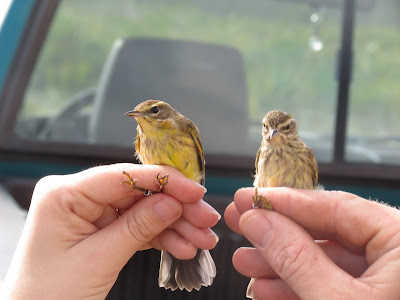Four of the banding team (myself, Nancy Price, Jane Wiewora, and Bill LaFramboise) decided to take a workshop to improve our banding skills. We attended one at the Yellow Rail and Rice Festival in Jennings, Louisiana. We drove and birded our way there and attended class on Thursday evening. A lot of new information is being developed on aging birds and we learned a lot. We will be looking at wing molt a lot differently now.
Friday morning we banded at a woodlot. There were new birds both caught and observed there. It was fun to hear Greater White-fronted Geese fly over. A sound we do not get in Florida. I'm not sure of the entire species list banded but some of the birds were: White-throated Sparrow, Song Sparrow, Eastern Phoebe, Ruby-crowned Kinglet (I banded it, new for me!), Northern Cardinal, Swamp Sparrow, and Brown Thrasher. A Northern Mockingbird from a previous festival was recaptured.
White-throated Sparrows (comparing two birds)
Photo by Jane Wiewora
Ruby-crowned Kinglet (#103)
Photos by Jane Wiewora
The bird was female so no "ruby crown" to show. After I banded the kinglet, our instructor showed us some details in the wing and then set it directly on the scale to be weighed. Be assured the bird is fine. Birds don't know what to do when they are on their backs - an unusual position for them. It flew off just fine and yes, the weight was obtained.
Ruby-crowned Kinglet
Photos by Jane Wiewora
We next went to the rice fields to see rice being harvested. As the combine works the fields, birds are flushed and nets catch some of the birds. Migrant rails use these fields to feed. We did not catch any Yellow Rails as Louisiana had so much recent rain the field we went to was too wet. They prefer drier fields. (They were seen by festival participants the day before and 2 were seen in this field.)
Rice combine harvesting
Rice being off loaded to truck
Close up of cut and not cut rows of rice
Photos by Nancy LaFramboise
We did however band 47!! Sora, 2 Virginia Rails, several Savannah and Swamp Sparrows. The Sora and Virginia Rails were my #104 and #105 birds banded.
Sora (not the one I banded)
Photo by Nancy LaFramboise
Sora - note holding the legs differently - don't want to get impaled by those toes!
Photo by Bill LaFramboise
Virginia Rail (not the one I banded)
Photo by Nancy LaFramboise
Unfortunately rain impeded much more banding. We birded Lacassine NWR and enjoyed a few birds we rarely get to see such as Neotropic Cormorant, Vermilion Flycatcher, and White-faced Ibis.
Homeward bound we had rain from Louisiana to past Pensacola. Nonetheless it was a great experience. I would recommend it to anyone!





























